 
Prevent diabetes problems: Keep your teeth and gums healthy
On this page:
What are diabetes problems?
Too much glucose in the blood for a long time can cause diabetes problems. This high blood glucose, also called blood sugar, can damage many parts of the body, such as the heart, blood vessels, eyes, and kidneys. Heart and blood vessel disease can lead to heart attacks and strokes. You can do a lot to prevent or slow down diabetes problems.
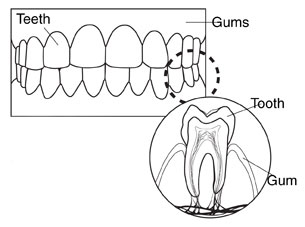
High blood glucose can cause tooth and gum problems.
This information is about the tooth and gum problems caused by diabetes. You will learn what you can do each day and during each year to stay healthy and prevent diabetes problems.
[Top]
What should I do each day to stay healthy with diabetes?
 |
Follow the healthy eating plan that you and your doctor or dietitian have worked out. |
 |
Be active a total of 30 minutes most days. Ask your doctor what activities are best for you. |
 |
Take your medicines as directed. |
 |
Check your blood glucose every day. Each time you check your blood glucose, write the number in your record book. |
 |
Check your feet every day for cuts, blisters, sores, swelling, redness, or sore toenails. |
 |
Brush and floss your teeth every day. |
 |
Control your blood pressure and cholesterol. |
 |
Don’t smoke. |
[Top]
How can diabetes hurt my teeth and gums?
Tooth and gum problems can happen to anyone. A sticky film full of germs, called plaque, builds up on your teeth. High blood glucose helps germs, also called bacteria, grow. Then you can get red, sore, and swollen gums that bleed when you brush your teeth.
People with diabetes can have tooth and gum problems more often if their blood glucose stays high. High blood glucose can make tooth and gum problems worse. You can even lose your teeth.
Smoking makes it more likely for you to get a bad case of gum disease, especially if you have diabetes and are age 45 or older.
Red, sore, and bleeding gums are the first sign of gum disease. These problems can lead to periodontitis. Periodontitis is an infection in the gums and the bone that holds the teeth in place. If the infection gets worse, your gums may pull away from your teeth, making your teeth look long.
Call your dentist if you think you have problems with your teeth or gums.
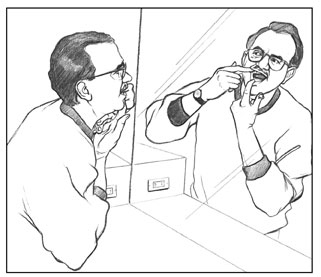
Check your teeth and gums for signs of problems from diabetes.
[Top]
How do I know if I have damage to my teeth and gums?
If you have one or more of these problems, you may have tooth and gum damage from diabetes:
- red, sore, swollen gums
- bleeding gums
- gums pulling away from your teeth so your teeth look long
- loose or sensitive teeth
- bad breath
- a bite that feels different
- dentures—false teeth—that do not fit well

[Top]
How can I keep my teeth and gums healthy?
- Keep your blood glucose as close to normal as possible.
- Use dental floss at least once a day. Flossing helps prevent the buildup of plaque on your teeth. Plaque can harden and grow under your gums and cause problems. Using a sawing motion, gently bring the floss between the teeth, scraping from bottom to top several times.
- Brush your teeth after each meal and snack. Use a soft toothbrush. Turn the bristles against the gum line and brush gently. Use small, circular motions. Brush the front, back, and top of each tooth.
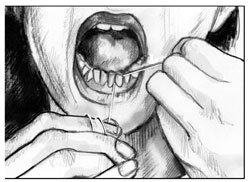
Brush and floss your teeth every day.
- If you wear false teeth, keep them clean.
- Call your dentist right away if you have problems with your teeth and gums.
- Call your dentist if you have red, sore, or bleeding gums; gums that are pulling away from your teeth; a sore tooth that could be infected; or soreness from your dentures.
- Get your teeth cleaned and your gums checked by your dentist twice a year.
- If your dentist tells you about a problem, take care of it right away.
- Be sure your dentist knows that you have diabetes.
- If you smoke, talk with your doctor about ways to quit smoking.
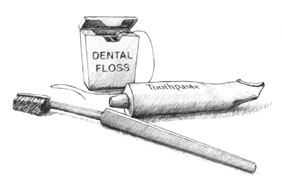
[Top]
How can my dentist take care of my teeth and gums?
Your dentist can help you take care of your teeth and gums by
- cleaning and checking your teeth twice a year
- helping you learn the best way to brush and floss your teeth
- telling you if you have problems with your teeth or gums and what to do about them
- making sure your false teeth fit well
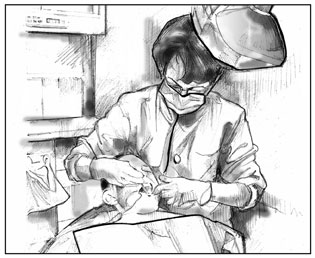
Get your teeth cleaned and checked twice a year.
Plan ahead. You may be taking a diabetes medicine that can cause low blood glucose, also called hypoglycemia. Talk with your doctor and dentist before the visit about the best way to take care of your blood glucose during the dental work. You may need to bring some diabetes medicine and food with you to the dentist’s office.
If your mouth is sore after the dental work, you might not be able to eat or chew for several hours or days. For guidance on how to adjust your normal routine while your mouth is healing, ask your doctor
- what foods and drinks you should have
- how you should change your diabetes medicines
- how often you should check your blood glucose
[Top]
Pronunciation Guide
hypoglycemia (HY-poh-gly-SEE-mee-uh)
periodontitis (PAIR-ee-oh-don-TY-tiss)
plaque (plak)
[Top]
For More Information
Diabetes Teachers (nurses, dietitians, pharmacists, and other health professionals)
To find a diabetes teacher near you, call the American Association of Diabetes Educators toll-free at 1–800–TEAMUP4 (832–6874), or look on the Internet at www.diabeteseducator.org and click on “Find a Diabetes Educator.”
Dietitians
To find a dietitian near you, call the American Dietetic Association toll-free at 1–800–877–1600, or look on the Internet at www.eatright.org and click on “Find a Nutrition Professional.”
Government
The National Institute of Dental and Craniofacial Research (NIDCR) is part of the National Institutes of Health. To learn more about tooth and gum problems, write or call the NIDCR’s information clearinghouse, the National Oral Health Information Clearinghouse (NOHIC), at 1 NOHIC Way, Bethesda, MD 20892–3500, 301–402–7364; or see www.nidcr.nih.gov/OralHealth/OralHealthInformation on the Internet.
To get more information about taking care of diabetes, contact
National Diabetes Information Clearinghouse
1 Information Way
Bethesda, MD 20892–3560
Phone: 1–800–860–8747
Fax: 703–738–4929
Email: ndic@info.niddk.nih.gov
Internet: www.diabetes.niddk.nih.gov
National Diabetes Education Program
1 Diabetes Way
Bethesda, MD 20892–3560
Phone: 1–800–438–5383
Fax: 703–738–4929
Internet: www.ndep.nih.gov
American Diabetes Association
1701 North Beauregard Street
Alexandria, VA 22311
Phone: 1–800–DIABETES (342–2383)
Internet: www.diabetes.org
Juvenile Diabetes Research Foundation International
120 Wall Street
New York, NY 10005–4001
Phone: 1–800–533–CURE (2873)
Internet: www.jdrf.org
This publication may contain information about medications used to treat a health condition. When this publication was prepared, the NIDDK included the most current information available. Occasionally, new information about medication is released. For updates or for questions about any medications, please contact the U.S. Food and Drug Administration at 1–888–INFO–FDA (463–6332), a toll-free call, or visit their website at www.fda.gov. Consult your doctor for more information.
[Top]
More in the Series
The “Prevent Diabetes Problems” Series has seven booklets that can help you learn more about how to prevent diabetes problems.
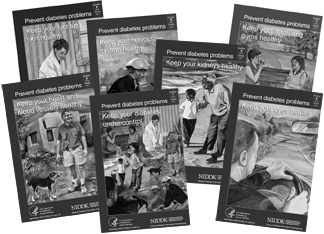
For free single copies of these booklets, write, call, fax, or email the
National Diabetes Information Clearinghouse
1 Information Way
Bethesda, MD 20892–3560
Phone: 1–800–860–8747
Fax: 703–738–4929
Email: ndic@info.niddk.nih.gov
These booklets are also available at www.diabetes.niddk.nih.gov on the Internet.
[Top]
Acknowledgments
The National Diabetes Information Clearinghouse thanks the people who helped review or field-test this publication.
For the American Association of Diabetes Educators
Lynn Grieger, R.D., C.D.E.
Arlington, VT
Celia Levesque, R.N., C.D.E.
Montgomery, AL
Teresa McMahon, Pharm.D., C.D.E.
Seattle, WA
Barbara Schreiner, R.N., M.N., C.D.E.
Galveston, TX
For the American Diabetes Association
Phyllis Barrier, M.S., R.D., C.D.E.
Alexandria, VA
Linda Haas, Ph.C., R.N., C.D.E.
Seattle, WA
Kathleen Mahoney, M.S.N., R.N., C.D.E.
Drexel Hill, PA
Randi Kington, M.S., R.N., C.S., C.D.E.
Hartford, CT
For the Centers for Medicare & Medicaid Services
Baltimore, MD
Jan Drass, R.N., C.D.E.
For the Diabetes Research and Training Centers
Albert Einstein School of Medicine
Norwalk Hospital
Norwalk, CT
Jill Ely, R.N., C.D.E.
Sam Engel, M.D.
Pam Howard, A.P.R.N., C.D.E.
Indiana University School of Medicine
Indianapolis, IN
Madelyn Wheeler, M.S., R.D., F.A.D.A., C.D.E.
VA/JDF Diabetes Research Center
Vanderbilt School of Medicine
Nashville, TN
Ok Chon Allison, M.S.N., R.N.C.S., A.N.P., C.D.E.
Barbara Backer, B.S.
James W. Pichert, Ph.D.
Alvin Powers, M.D.
Melissa E. Schweikhart
Michael B. Smith
Kathleen Wolffe, R.N.
For the Grady Health System Diabetes Clinic
Atlanta, GA
Ernestine Baker, R.N., F.N.P., C.D.E.
Kris Ernst, R.N., C.D.E.
Margaret Fowke, R.D., L.D.
Kay Mann, R.N., C.D.E.
For the Indian Health Service
Albuquerque, NM
Ruth Bear, R.D., C.D.E.
Dorinda Bradley, R.N., C.D.E.
Terry Fisher, R.N.
Lorraine Valdez, R.N., C.D.E.
Red Lake, MN
Charmaine Branchaud, B.S.N., R.N., C.D.E.
For the Medlantic Research Center
Washington, DC
Resa Levetan, M.D.
For the Texas Diabetes Council
Texas Department of Health
Austin, TX
Luby Garza-Abijaoude, M.S., R.D., L.D.
Marc Shlossman, D.D.S., M.S.
Chandler, AZ
[Top]
National Diabetes Information Clearinghouse
1 Information Way
Bethesda, MD 20892–3560
Phone: 1–800–860–8747
TTY: 1–866–569–1162
Fax: 703–738–4929
Email: ndic@info.niddk.nih.gov
Internet: www.diabetes.niddk.nih.gov
The National Diabetes Information Clearinghouse (NDIC) is a service of
the National Institute of Diabetes and Digestive and Kidney Diseases (NIDDK).
The NIDDK is part of the National Institutes of Health of the U.S. Department
of Health and Human Services. Established in 1978, the Clearinghouse provides
information about diabetes to people with diabetes and to their families,
health care professionals, and the public. The NDIC answers inquiries, develops
and distributes publications, and works closely with professional and
patient organizations and Government agencies to coordinate resources
about diabetes.
Publications produced by the Clearinghouse are carefully reviewed by both NIDDK scientists and outside experts.
This publication is not copyrighted. The Clearinghouse encourages users of
this publication to duplicate and distribute as many copies as desired.
NIH Publication No. 08–4280
April 2008
[Top]
|




